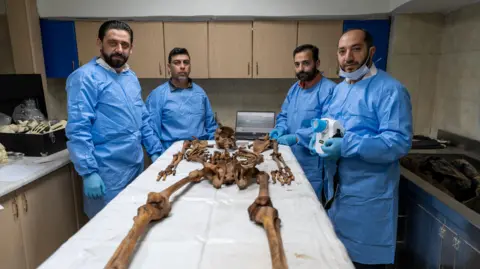The aftermath of Syria’s long-standing civil war has revealed a grim reality: tens of thousands of remains lie in mass graves, testifying to the tragic toll of conflicts waged under the regime of Bashar al-Assad and his father, Hafez al-Assad. In the Syrian Identification Centre, established to confront this harrowing history, Dr. Anas al-Hourani, a forensic odontologist, explains the challenging process of identifying victims. With tables covered in femurs, Dr. al-Hourani emphasizes that each bone tells a story about the individual’s life, including their height, sex, age, and even signs of torture. This meticulous sorting of bone fragments is essential in the long quest for justice in a nation vying for its painful narrative to be acknowledged.
Dr. al-Hourani shares insights into the tools and processes needed for identification, noting the limitations faced in Syria due to damage from the civil war. The scarcity of DNA testing facilities, compounded by sanctions that restrict access to necessary chemicals, severely limits the ability to conduct thorough identifications. In fact, the lab currently relies on financial support from the International Committee of the Red Cross, highlighting how the once robust systems for forensic investigation have crumbled amidst ongoing conflict.
As time goes on, the government’s transition led by newly appointed Islamist rebels has pledged to prioritize what is termed “transitional justice,” but the community’s sentiment remains largely skeptical. Families who have suffered lost loved ones demand tangible efforts and accountability, given that estimates suggest over 130,000 individuals have been forcibly disappeared since the onset of the war. Dr. al-Hourani warns that even at optimal capacity, identifying a single victim could take months; this daunting reality implies that providing closure for families may stretch over multiple years.
On the ground, accounts from individuals like Abu Ali, a former military driver, provide firsthand insights into the disheartening practices surrounding these mass graves. Having spent over a decade transporting corpses for disposal, Abu Ali’s testimony reveals the broader mechanisms of violence. He describes a chilling routine wherein he would deliver lorry-loads of bodies to burial sites, with soldiers discarding them like refuse in shallow graves, compressed beneath heavier machinery. The acceptance and dehumanization displayed in these actions are stark reflections of the totalitarian grip of the regime.
Amid these accounts lies a deeply personal sorrow shared by many families, such as that of Malak Aoude, whose two sons disappeared under ambiguous circumstances. As Malak navigates her search for closure, she faces both systemic indifference and the emotional weight of her loss. Her sons’ fates—one presumed dead, the other forcibly taken—illustrate the pervasive instability and trauma that enveloped the nation as dissent and protest against the regime escalated into violence.
During her exploration for answers, Malak is confronted with fragmented records that only scratch the surface of her tragic narrative, leaving her entangled in uncertainty. The muted hope surrounding the regime’s downfall could not extinguish the pain rooted in her heart. Even with the potential for change, the shadows of oppression linger in stories that still seek recognition.
Collectively, the testimonies of those affected by the conflict, including testimonies from survivors and witnesses, weave a broader narrative of human resilience threatened by the brutal reality of political oppression. While the path to justice may seem daunting, the commitment demonstrated by medics, families, and activists reflects a collective yearning for truth in the face of overwhelming grief. Each effort, albeit small, fuels hope for a future where the stories of those silenced will not be forgotten, transforming the pain of memory into an enduring pursuit of understanding and peace in the heart of Syria.



